|
Size: 393
Comment:
|
Size: 5490
Comment:
|
| Deletions are marked like this. | Additions are marked like this. |
| Line 2: | Line 2: |
== Code zur Kartendarstellung == {{{#!Python import Image from pylab import * from mpl_toolkits.basemap import Basemap import numpy as np def load_img(filename): im=Image.open(filename) return resize(fromstring(im.tostring(),uint8),(im.size[1],im.size[0],3)) import scipy.ndimage as nd # define coordinates of profile lat_glatt=[77.0,78.0,79.0] lon_glatt_start,lon_glatt_stop=2.0,10.0 filename='AERONET_Hornsund.2009072.aqua.250m.jpg' a=load_img(filename) a=nd.zoom(a[:,:,0],0.2) north=80.2363 south=73.7612 east=40.4156 west=-9.3026 filename='AERONET_Hornsund.2009072.aqua.250m.jgw' cds=array(open(filename).read().split('\n')[:-1]).astype(float) [yn,xn]=shape(a) # make grid x=linspace(west,east,xn) y=linspace(north,south,yn) [lons,lats] = meshgrid(x,y) start=find(x>lon_glatt_start)[0] stop=find(x>lon_glatt_stop)[0] line=[] for i in lat_glatt: line.append(find(y<i)[0]) figure(2) m=Basemap(projection='merc',llcrnrlat=74,urcrnrlat=80,llcrnrlon=-9,urcrnrlon=20,resolution='h') xm,ym=m(lons,lats) xi=linspace(m.llcrnrx,m.urcrnrx,xn) # define the new grid yi=linspace(m.llcrnry,m.urcrnry,yn) modis_img_nmpg=griddata(xm.flatten(),ym.flatten(),a.flatten(),xi,yi) m.imshow(modis_img_nmpg,cm.bone, interpolation='bilinear',aspect='auto') m.drawcoastlines() m.fillcontinents(color='gray',lake_color='aqua') m.drawmapboundary(fill_color='aqua') m.drawmeridians(np.arange(0,360,5),labels=[1,0,0,1]) m.drawparallels(np.arange(-90,90,2),labels=[0,1,0,1]) cls=('ryg') for k,i in enumerate(line): x1,y1=m(x[start],y[i]) x2,y2=m(x[stop],y[i]) m.plot([x1,x2],[y1,y2],'-'+cls[k],linewidth=3) for j in range(182,191): x,y=m(j-180.,77) m.plot(x,y,'b.',markersize=12) x,y=m(j-180.,78) m.plot(x,y,'b.',markersize=12) x,y=m(j-180.,79) m.plot(x,y,'b.',markersize=12) show() savefig('modis_test.png') }}} {{attachment:modis_test.png}} == Längenspektren über die Profile == {{{#!python import Image from pylab import * from mpl_toolkits.basemap import Basemap import numpy as np from scipy import ndimage def load_img(filename): im=Image.open(filename) return resize(fromstring(im.tostring(),uint8),(im.size[1],im.size[0],3)) def mitteln(bild,ref_y,ref_x_start,ref_x_stop,h): y_inds=range(ref_y-h,ref_y+h) tempo=zeros([len(y_inds),ref_x_stop-ref_x_start]) k=0 for i in y_inds: tempo[k,:]=a[i,ref_x_start:ref_x_stop,0] k=k+1 out=mean(tempo,0) return out # define coordinates of profile lat_glatt=79.0 lon_glatt_start,lon_glatt_stop=2.0,10.0 # load data filename='AERONET_Hornsund.2009072.aqua.250m.jpg' a=load_img(filename) north=80.2363 south=73.7612 east=40.4156 west=-9.3026 [yn,xn,dum]=shape(a) # make grid x=linspace(west,east,xn) y=linspace(north,south,yn) [lons,lats] = meshgrid(x,y) start=find(x>lon_glatt_start)[0] stop=find(x>lon_glatt_stop)[0] line=find(y<lat_glatt)[0] test=mitteln(a,line,start,stop,30) test=ndimage.gaussian_filter1d(test,3) # power spectrum figure(1) [pxx,freq]=psd(test,NFFT=512,Fs=1,Fc=0,detrend=mlab.detrend_linear,window=mlab.window_hanning, noverlap=0) # plot spectrum selber figure(2) freq=0.25/freq plot(freq[1:],pxx[1:],'g-') xlim((0,40)) xlabel('Zelldurchmesser [km]') ylabel('spektrale Dichte') # plot schnitt figure(3) plot(test,'r-') show() }}} === 77°N === {{attachment:spek_77.png}} === 78°N === {{attachment:spek_78.png}} === 79°N === {{attachment:spek_79.png}} |
|
| Line 6: | Line 182: |
| # an die anderen for j in range(178,191): x,y=m(j-180.,77) m.plot(x,y,'r.') x,y=m(j-180.,78) m.plot(x,y,'b.') x,y=m(j-180.,79) m.plot(x,y,'g.')}}} |
#!/bin/tcsh from pyhdf import SD from pylab import * from mpl_toolkits.basemap import Basemap fid=SD.SD('AIRS.2003.03.30.L3.RetStd001.v5.0.14.0.G07215021620.hdf') T=fid.select('Temperature_A') Temp=T.get() #Drucklevel Lv=[1000.0,925.0,850.0,700.0,600.0,500.0,400.0,300.0,250.0,200.0,150.0,100.0, 70.0, 50.0,30.0, 20.0, 15.0, 10.0, 7.0,5.0, 3.0,2.0,1.5,1.0] # Temperaturprofile figure(1) plot(Temp[:,13,187],Lv) ylim((1000.0,1.0)) xlim((200.0,280.0)) xlabel('T in Kelvin') ylabel('p in hPa') title('used profiles lon=77') show() savefig('Soundings1.png',dpi=75) figure(2) plot(Temp[:,12,184],Lv) ylim((1000.0,1.0)) xlim((200.0,280.)) xlabel('T in Kelvin') ylabel('p in hPa') title('used profiles lon=78') show() savefig('Soundings2.png',dpi=75) figure(3) plot(Temp[:,11,187],Lv) ylim((1000.0,1.0)) xlim((200.0,280.0)) xlabel('T in Kelvin') ylabel('p in hPa') title('used profiles lon=79') show() savefig('Soundings3.png',dpi=75) }}} |
| Line 16: | Line 227: |
== Grenschichthöhe == |
{{attachment:Soundings1.png}} {{attachment:Soundings2.png}} {{attachment:Soundings3.png}} == Grenzschichthöhe == Grenzschichtdicke in Meter umrechnen mit barometrischer Höhenformel: {{{#!latex $\Delta z = \frac{R_L T}{g}ln\left(\frac{p}{p_s}\right)$}}} R=287,1J/kgK Annahme: T=const. (dadurch wird Grenzschichtdicke unterschätzt) p=Druckniveau der Wolkenobergrenze ps=Bodendruck aus Karte Werte: || Breite || Dicke in hPa || Dicke in km || || 77 || 165 - 315 || 1,2 - 2,6 || || 78 || 90 - 165 || 0,6 - 1,2 || || 79 || 90 - 165 || 0,6 - 1,2 || genauere Bestimmung ist aufgrund der groben Auflösung der Drucklevel nicht möglich: Fehler in Größenordnung 1km |
Zusammenfassung Konvektionszellen
Code zur Kartendarstellung
1 import Image
2 from pylab import *
3 from mpl_toolkits.basemap import Basemap
4 import numpy as np
5
6 def load_img(filename):
7 im=Image.open(filename)
8 return resize(fromstring(im.tostring(),uint8),(im.size[1],im.size[0],3))
9
10 import scipy.ndimage as nd
11 # define coordinates of profile
12 lat_glatt=[77.0,78.0,79.0]
13 lon_glatt_start,lon_glatt_stop=2.0,10.0
14
15
16
17 filename='AERONET_Hornsund.2009072.aqua.250m.jpg'
18
19
20 a=load_img(filename)
21
22 a=nd.zoom(a[:,:,0],0.2)
23
24 north=80.2363
25 south=73.7612
26 east=40.4156
27 west=-9.3026
28
29 filename='AERONET_Hornsund.2009072.aqua.250m.jgw'
30 cds=array(open(filename).read().split('\n')[:-1]).astype(float)
31
32
33
34 [yn,xn]=shape(a)
35
36 # make grid
37 x=linspace(west,east,xn)
38 y=linspace(north,south,yn)
39
40 [lons,lats] = meshgrid(x,y)
41
42 start=find(x>lon_glatt_start)[0]
43 stop=find(x>lon_glatt_stop)[0]
44
45 line=[]
46 for i in lat_glatt:
47 line.append(find(y<i)[0])
48
49 figure(2)
50
51 m=Basemap(projection='merc',llcrnrlat=74,urcrnrlat=80,llcrnrlon=-9,urcrnrlon=20,resolution='h')
52
53 xm,ym=m(lons,lats)
54
55 xi=linspace(m.llcrnrx,m.urcrnrx,xn) # define the new grid
56 yi=linspace(m.llcrnry,m.urcrnry,yn)
57 modis_img_nmpg=griddata(xm.flatten(),ym.flatten(),a.flatten(),xi,yi)
58
59
60 m.imshow(modis_img_nmpg,cm.bone, interpolation='bilinear',aspect='auto')
61 m.drawcoastlines()
62 m.fillcontinents(color='gray',lake_color='aqua')
63 m.drawmapboundary(fill_color='aqua')
64
65 m.drawmeridians(np.arange(0,360,5),labels=[1,0,0,1])
66 m.drawparallels(np.arange(-90,90,2),labels=[0,1,0,1])
67
68 cls=('ryg')
69 for k,i in enumerate(line):
70 x1,y1=m(x[start],y[i])
71 x2,y2=m(x[stop],y[i])
72 m.plot([x1,x2],[y1,y2],'-'+cls[k],linewidth=3)
73
74
75
76 for j in range(182,191):
77 x,y=m(j-180.,77)
78 m.plot(x,y,'b.',markersize=12)
79 x,y=m(j-180.,78)
80 m.plot(x,y,'b.',markersize=12)
81 x,y=m(j-180.,79)
82 m.plot(x,y,'b.',markersize=12)
83
84 show()
85 savefig('modis_test.png')
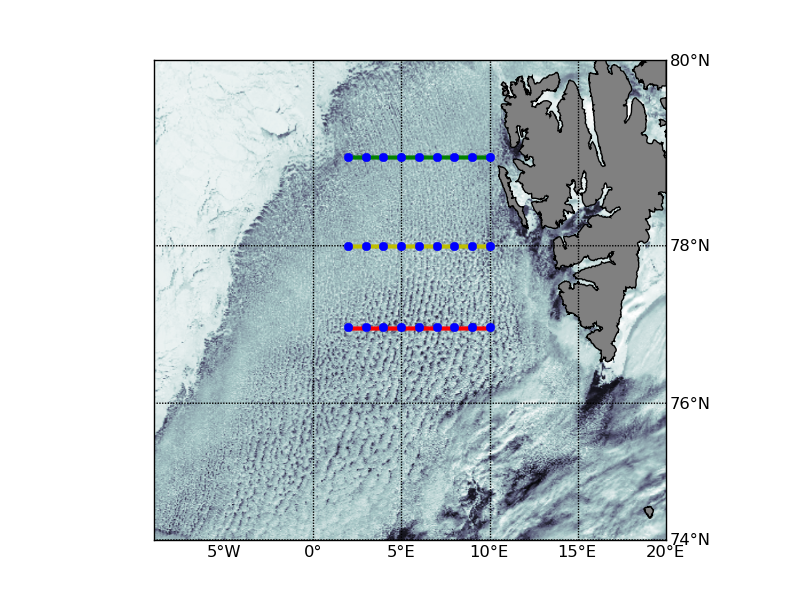
Längenspektren über die Profile
1 import Image
2 from pylab import *
3 from mpl_toolkits.basemap import Basemap
4 import numpy as np
5 from scipy import ndimage
6
7 def load_img(filename):
8 im=Image.open(filename)
9 return resize(fromstring(im.tostring(),uint8),(im.size[1],im.size[0],3))
10
11 def mitteln(bild,ref_y,ref_x_start,ref_x_stop,h):
12 y_inds=range(ref_y-h,ref_y+h)
13 tempo=zeros([len(y_inds),ref_x_stop-ref_x_start])
14 k=0
15 for i in y_inds:
16 tempo[k,:]=a[i,ref_x_start:ref_x_stop,0]
17 k=k+1
18
19 out=mean(tempo,0)
20 return out
21
22 # define coordinates of profile
23 lat_glatt=79.0
24 lon_glatt_start,lon_glatt_stop=2.0,10.0
25
26
27 # load data
28 filename='AERONET_Hornsund.2009072.aqua.250m.jpg'
29
30 a=load_img(filename)
31
32
33 north=80.2363
34 south=73.7612
35 east=40.4156
36 west=-9.3026
37
38 [yn,xn,dum]=shape(a)
39
40 # make grid
41 x=linspace(west,east,xn)
42 y=linspace(north,south,yn)
43
44 [lons,lats] = meshgrid(x,y)
45
46 start=find(x>lon_glatt_start)[0]
47 stop=find(x>lon_glatt_stop)[0]
48 line=find(y<lat_glatt)[0]
49
50 test=mitteln(a,line,start,stop,30)
51 test=ndimage.gaussian_filter1d(test,3)
52
53 # power spectrum
54 figure(1)
55 [pxx,freq]=psd(test,NFFT=512,Fs=1,Fc=0,detrend=mlab.detrend_linear,window=mlab.window_hanning, noverlap=0)
56
57 # plot spectrum selber
58 figure(2)
59 freq=0.25/freq
60 plot(freq[1:],pxx[1:],'g-')
61 xlim((0,40))
62 xlabel('Zelldurchmesser [km]')
63 ylabel('spektrale Dichte')
64
65 # plot schnitt
66 figure(3)
67 plot(test,'r-')
68
69 show()
77°N
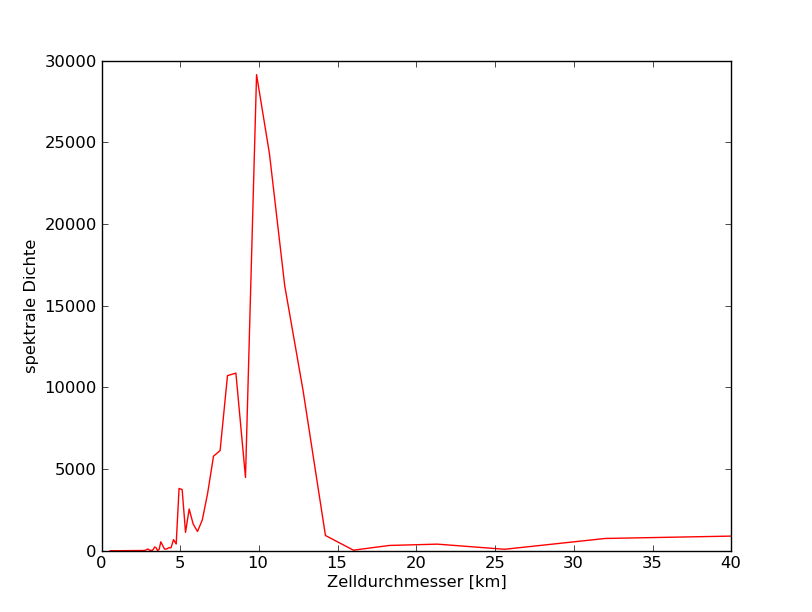
78°N

79°N
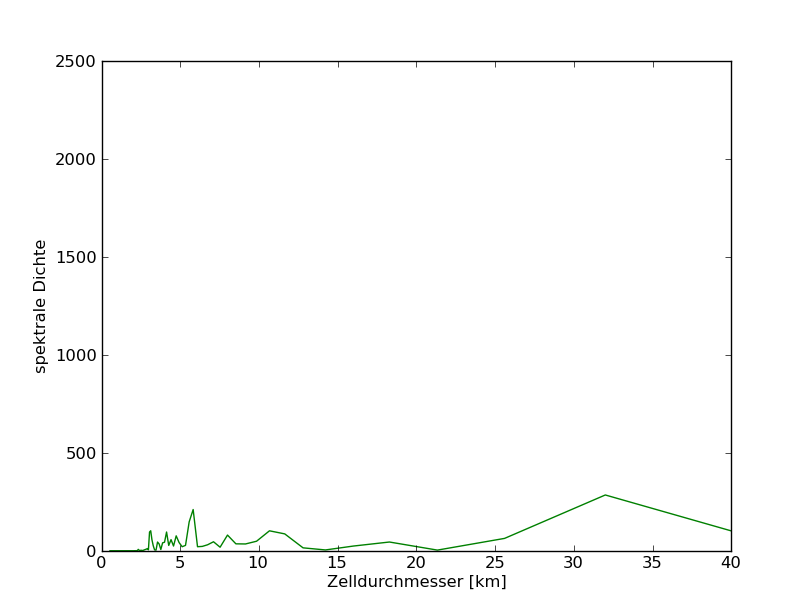
Zusammenfassung Grenzschicht
Programmcode
1 #!/bin/tcsh
2
3 from pyhdf import SD
4 from pylab import *
5 from mpl_toolkits.basemap import Basemap
6
7 fid=SD.SD('AIRS.2003.03.30.L3.RetStd001.v5.0.14.0.G07215021620.hdf')
8 T=fid.select('Temperature_A')
9 Temp=T.get()
10
11 #Drucklevel
12 Lv=[1000.0,925.0,850.0,700.0,600.0,500.0,400.0,300.0,250.0,200.0,150.0,100.0,
13 70.0, 50.0,30.0, 20.0, 15.0, 10.0, 7.0,5.0, 3.0,2.0,1.5,1.0]
14
15 # Temperaturprofile
16 figure(1)
17 plot(Temp[:,13,187],Lv)
18 ylim((1000.0,1.0))
19 xlim((200.0,280.0))
20 xlabel('T in Kelvin')
21 ylabel('p in hPa')
22 title('used profiles lon=77')
23 show()
24 savefig('Soundings1.png',dpi=75)
25 figure(2)
26 plot(Temp[:,12,184],Lv)
27 ylim((1000.0,1.0))
28 xlim((200.0,280.))
29 xlabel('T in Kelvin')
30 ylabel('p in hPa')
31 title('used profiles lon=78')
32 show()
33 savefig('Soundings2.png',dpi=75)
34 figure(3)
35 plot(Temp[:,11,187],Lv)
36 ylim((1000.0,1.0))
37 xlim((200.0,280.0))
38 xlabel('T in Kelvin')
39 ylabel('p in hPa')
40 title('used profiles lon=79')
41 show()
42 savefig('Soundings3.png',dpi=75)
Profile

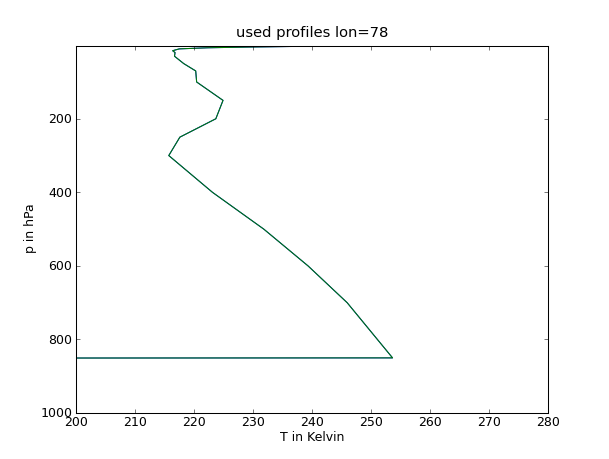
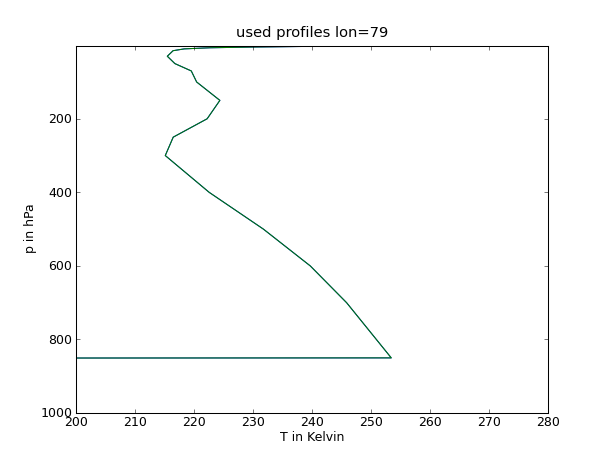
Grenzschichthöhe
Grenzschichtdicke in Meter umrechnen mit barometrischer Höhenformel:
latex error! exitcode was 2 (signal 0), transscript follows:
R=287,1J/kgK
Annahme: T=const. (dadurch wird Grenzschichtdicke unterschätzt)
p=Druckniveau der Wolkenobergrenze
ps=Bodendruck aus Karte
Werte:
Breite |
Dicke in hPa |
Dicke in km |
77 |
165 - 315 |
1,2 - 2,6 |
78 |
90 - 165 |
0,6 - 1,2 |
79 |
90 - 165 |
0,6 - 1,2 |
genauere Bestimmung ist aufgrund der groben Auflösung der Drucklevel nicht möglich: Fehler in Größenordnung 1km
Vergleichen mit Theorie
latex error! exitcode was 2 (signal 0), transscript follows:
